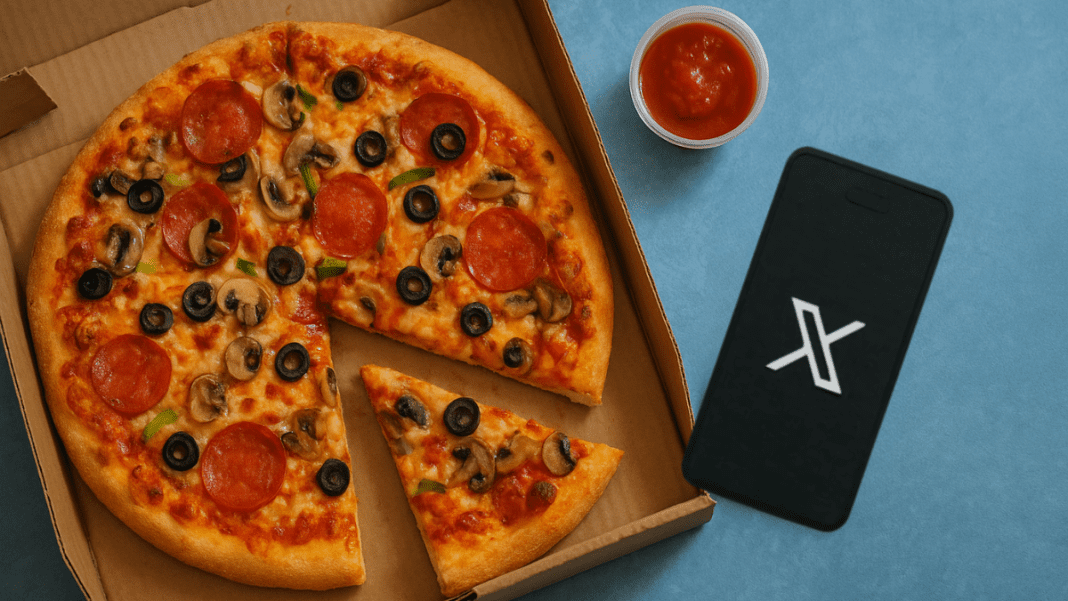A sudden surge in pizza orders near the Pentagon and nearby areas has caught attention online. An X account called Pentagon Pizza Report, which tracks pizza orders from restaurants close to government buildings like the Pentagon and CIA, reported an unusual spike on Friday.
Sudden rise in pizza orders near Pentagon
The account highlighted orders from well-known outlets such as Freddies Beach Bar, Domino’s Pizza, District Pizza Palace, and Crystal City Sports Pub. The exact reason for the rise was not mentioned, but the timing and scale of the orders led to curiosity among online users.
At around 1 PM ET on Friday, the account posted that pizzerias close to the Pentagon were experiencing high traffic. Later in the evening, around 7:36 PM, another update noted that pizza orders had become mixed, ranging between below average and above average.
Social media reactions quickly followed. Some users pointed out a massive spike at one location, noting that Pizzato Pizza, a shop near the Pentagon open late at night, saw orders rise by 303% in a single day. People widely shared screenshots of delivery analysis, fueling speculation about the unusual surge.
Pentagon backs trial of AI battle manager that cuts response times for US fighter jet missions
This was not the first time observers reported such activity. Earlier in the week, on August 27 and 28, the same account observed similar spikes in pizza orders from outlets surrounding the Pentagon.
What is the Pentagon Pizza Index?
The unusual pattern has revived interest in what is popularly known as the “Pentagon Pizza Index.” This is an informal theory that connects sudden increases in pizza deliveries near intelligence headquarters with possible national security concerns or military activity.
According to the idea, when government staff work late into the night, a rise in food deliveries can sometimes follow. The theory suggests that monitoring pizza orders might provide hints about something serious happening behind closed doors.
Startling Pentagon Controversy: Musk’s Access to China War Plans Sparks National Security Concerns
However, there is no evidence that these food order spikes actually link to government decisions. The idea has mainly spread as a viral theory on social media. People have discussed it for years, treating it as an unusual but entertaining observation rather than a verified signal of events.
Still, whenever people report an unusual rise in late-night pizza orders near government buildings, the Pentagon Pizza Index trends again. Online discussions mix humor, curiosity, and speculation, showing how easily small patterns can gain wide attention.
Cold War origins of the theory
The story of the Pentagon Pizza Index is not new. Its roots trace back to the Cold War period. Reports suggest that Soviet spies once monitored pizza deliveries in Washington, D.C. They believed that sudden increases in late-night orders near the Pentagon or CIA could signal urgent activity or preparations for major operations.
At that time, intelligence agencies looked at everyday signals, like food deliveries, to guess what might be happening inside secure offices. For example, in August 1990, observers noticed a sudden surge in pizza orders at a Domino’s franchise in Washington just hours before Iraq invaded Kuwait. This observation drew more attention to the theory and strengthened the belief that pizza deliveries could sometimes hint at global events.
People following food orders even gave the practice a nickname—“Pizzint,” short for pizza intelligence. The term became part of the quirky culture around intelligence monitoring. It also showed how people could interpret small, everyday activities as signs of bigger movements in world affairs.
Pentagon reportedly plans military options for Chicago as Illinois leaders deny federal request
Over time, people treated the Pentagon Pizza Index less as actual intelligence work and more as a mix of pop culture and internet fascination. Even today, whenever people notice a sudden spike in pizza deliveries, social media users quickly bring the term back into discussion.
The most recent surge has once again pushed the idea into the spotlight. While the reasons for the spike in Pentagon-area orders remain unclear, the reaction shows how deeply the Pentagon Pizza Index has entered public imagination. For many, it remains a curious reminder of how simple details, like ordering pizza, can spark conversations far beyond the dinner table.

